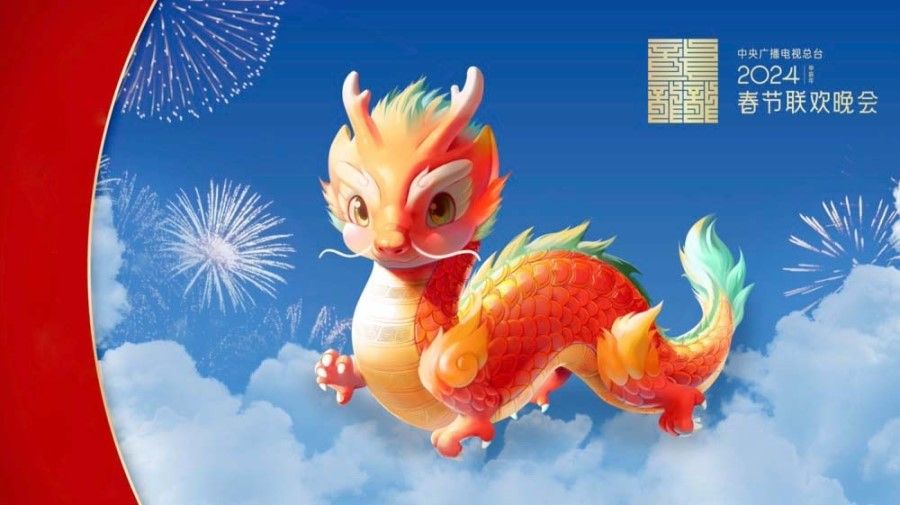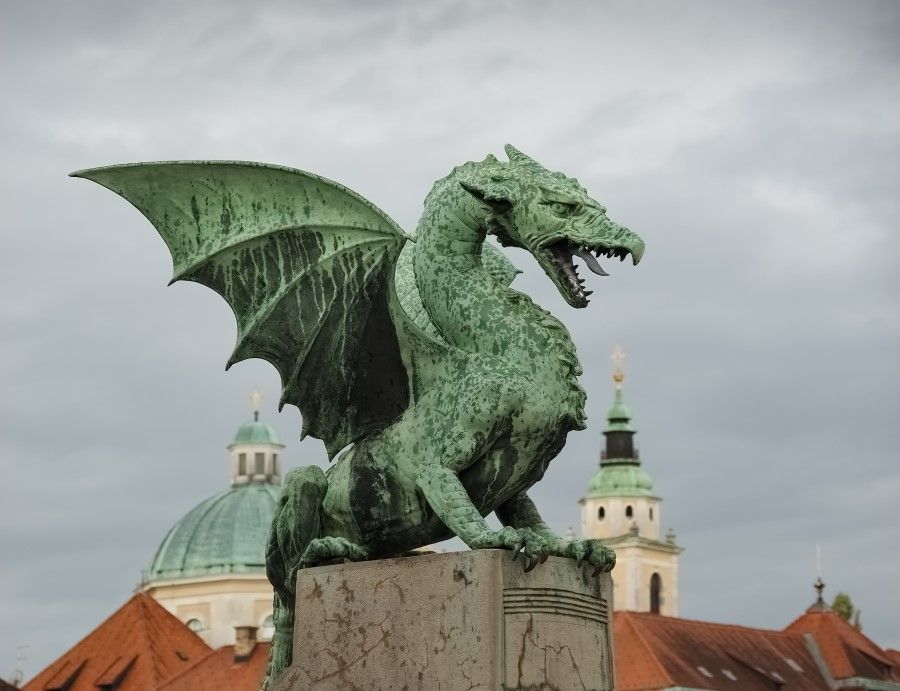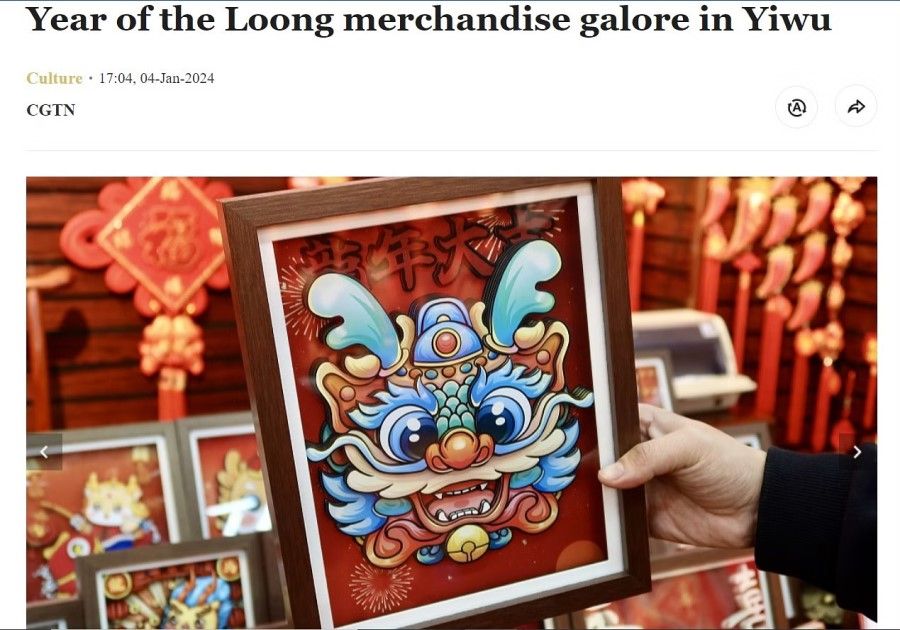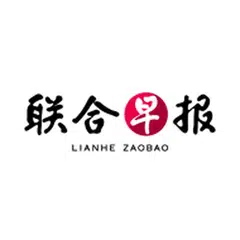'Loong' or dragon?

With the arrival of the Year of the Dragon, there has been a heated debate among Chinese netizens on whether the English translation of 龙 (long) should be "dragon" or "loong", and the topic even briefly topped the trending list on Weibo.
The discussion stems from the official use of "loong" in translations for Chinese New Year events and reports this year in China. Shortly after the start of the year, China Global Television Network (CGTN), which is aimed at English-speaking audiences, translated 龙年 as Year of the Loong when reporting on Spring Festival items with dragon elements at the Yiwu International Trade City. Subsequently, they also translated 龙舞 (long wu) as Loong Dance in other reports. The English name for the CCTV Spring Festival Gala mascot 龙辰辰 (long chen chen) was also rendered as Loong Chenchen.
An article by the Shanghai Writers' Association pointed out that "loong" sounds similar to "long", with the two "o"s resembling the bright and shining eyes of a dragon. It further said that the translation captures the pictorial and semantic features of Chinese characters, and that the elongated "long" better describes the long, slender shape of a dragon or dragon boat.
... since the 13th century, foreigners have called the 龙 in the palaces of the Yuan dynasty "dragons".

As for why 龙 was previously translated as dragon, A Xinhua article notes that the term "dragon" appeared as early as Marco Polo's travelogue about the East; he might have believed that the Chinese architectural depiction of dragons bore certain resemblances to the Western concept of dragons.
The article adds that the British missionary Robert Morrison compiled A Dictionary of the Chinese Language, which also translated 龙 as dragon. Peng Ping, professor and vice-dean of the School of English and International Studies at Beijing Foreign Studies University, is quoted as saying that this dictionary had a profound influence, and this translation spread among the majority of Westerners, and is still around today.
Thus, since the 13th century, foreigners have called the 龙 in the palaces of the Yuan dynasty "dragons".
However, "loong" has also been used for a long time. In the early 19th century, the British missionary Joshua Marshman, in his book Elements of Chinese Grammar, still translated it as "dragon", but phonetically annotated 龙 as "loong", showing that "loong" is not a term recently proposed by the Chinese, and it is not uncommon for foreigners to transliterate the names of things unique to other countries.
Chinese dragons typically feature a horse head, eagle claws, fish scales, deer horns, and the body of a snake, and they are wingless, symbolising good luck and auspiciousness.
Dragons: good in China, evil in the West
So what are the differences between Western dragons and Chinese dragons? Luca Nurmio, a scholar at the University of Luxembourg, said in the same Xinhua article, that the Chinese dragon is friendly and benevolent, while Western dragons are often depicted as monsters, so there is a clear difference. He feels it would be good to call it loong, because "Western dragons don't really reflect the Chinese culture in this way."
British sinologist Frances Wood also pointed out in the same article that in China, the dragon is a symbol of nobility with a very positive image, unlike the image of Western dragons. She believes that considering the current understanding and acceptance of the audience, it may be appropriate to translate it as "Chinese dragon". The Oxford English Dictionary previously had the entry "Chinese dragon", with annotations emphasising the positive significance of dragons in Chinese culture.

Chinese media note that Western dragons usually breathe fire, have large wings, and are fierce and aggressive, and are generally depicted negatively. In contrast, Chinese dragons typically feature a horse head, eagle claws, fish scales, deer horns, and the body of a snake, and they are wingless, symbolising good luck and auspiciousness. The two are vastly different, so translating 龙 as "loong" is closer to the original meaning of Chinese dragons, while "dragon" is inaccurate, especially considering there are precedents for translating it as "loong".
Decades of discussion
In fact, the Chinese academic community has been discussing translations for 龙 for decades. According to research conducted over 20 years ago by then Associate Professor Huang Ji from the School of Communication at East China Normal University, translator Professor Lü Binghong was one of the earliest scholars in China to say that 龙 should not be translated as "dragon".
According to an article by Huang, Lü wrote in a 1987 article that in Chinese culture, the dragon represents the emperor and symbolises nobility. There are dragon boats, dragon lanterns, and the saying 龙凤呈祥 (dragons and phoenixes bring auspiciousness), where the dragon symbolises auspiciousness. There are many legends and metaphors related to dragons in China, and the Chinese people are called the "descendants of the dragon". For example, the metaphor 他在县里是条龙,到了省里成了条虫 (He was a dragon in the county, but a worm in the province) - here, "dragon" implies authority and power, whereas in English, a "dragon" is something violent, combative, formidable, baneful. If someone says "his wife is a dragon", the metaphor has a negative connotation.
Huang adds in his article that later, people like Chinese anthropologist Professor Yan Yunxiang and English language expert Ge Chuangui also said that 龙 and "dragon" should not be translated interchangeably.

Huang goes on to say that the Chinese people's interest in the translation of 龙 goes back to November 2005, when the mascot for the 2008 Beijing Olympics was unveiled, and the dragon was surprisingly not selected despite being a favourite. The Olympic Organizing Committee explained that the dragon has different connotations around the world, and the Western perception of dragons does not align with the emotional significance that Chinese people attach to them, which could lead to misunderstandings, so it was not suitable as the Olympic mascot.
Huang adds that one might say the dragon is the most important symbol in Chinese culture, and the Olympics are a globally renowned sporting event, presenting the best opportunity to showcase Chinese culture. Not making the dragon the Olympic mascot suddenly made people aware of the significance of translating the word 龙.
Since then, there has been debate on the translation of 龙. During the Two Sessions (两会) in 2015 between the National People's Congress (NPC) and Chinese People's Political Consultative Conference (CPPCC), a CPPCC member proposed further clarification on the English translation of 龙 and called for its translation as "loong".
... changing "dragon" to "loong" reflects China's desire to control the narrative, but it is mostly for self-amusement. - Johnny Lau, a Hong Kong current affairs commentator
Gradual transliteration of 龙
As mentioned by Huang, in recent years, many Chinese companies and organisations have begun to adopt this approach. For example, the English name for China's first CPU chip 龙芯 is Loongson; there is Zhejiang Loong Airlines; and the English title for the film 龙之战 (lit. The War of Dragons), produced by the National Radio and Television Administration and other units, is The War of Loong.
The article adds that with 龙 gradually being transliterated, some Chinese institutions have also chosen to transliterate certain cultural terms. In 2009, the Chinese National Sports Administration announced that, in order to promote the global popularity and dissemination of Chinese chess, the English transliteration "xiangqi" would be used instead of the previously common Chinese chess. Another example is 粽子, which was officially translated as "zongzi" in English in 2020, and not "rice dumpling" as before.

The Yangtze Evening Post quoted Cheng Shuiying, an English teacher with the School of Foreign Languages at Nanjing University of Finance and Economics, who said transliteration is a clever translation method for some proprietary terms in Chinese with traditional cultural connotations, as it allows cultural information from the source language to be conveyed to the target language readers. Besides "zongzi", other examples include 功夫 (kungfu) and 豆腐 (tofu).
Cheng said nowadays, the translation of 龙 as "loong" is increasingly accepted.
Hu Xijin, former Global Times editor-in-chief, wrote on 8 February that as China moves towards the world and embraces the world, the process of reshaping the "loong" image will continue. He said, "This is a long-term, challenging process of changing mindsets."
Hu wrote that there is now a global demand, including from the West, to understand China's "loong", even though some still perceive China's rise as a "dragon"-like threat. Like it or not, they must adapt to a new form of globalisation and coexist with China. "Eventually, they will see from China's development that 'loong' is not 'dragon'."
Hong Kong current affairs commentator Johnny Lau believes that changing "dragon" to "loong" reflects China's desire to control the narrative, but it is mostly for self-amusement. In an interview with BBC Chinese, he explained that such practices violate established linguistic conventions, and he believes that "loong" is unlikely to become the mainstream usage worldwide. "Language is dynamic and evolves with time. If all words need to be traced back to the original language, this is not a modern way of thinking."
Nevertheless, discussions on the translation of 龙 continue to grow in international circles, showing that Chinese culture is spreading.
But if one day the English translation of the Chinese 龙 is confirmed as "loong" rather than "dragon", what should the Chinese translation of the Western "dragon" be?
This article was first published in Lianhe Zaobao as "中国拟为龙正名loong?".
